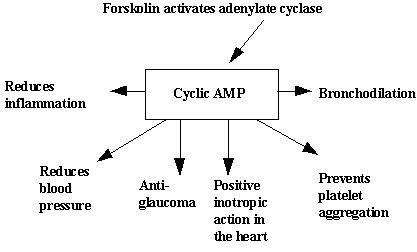Coleus forskohlii belongs to the Natural Order Labiatae (Lamiaceae), a family of mints and lavenders. This species is a perennial herb with fleshy, fibrous roots that grows wild in the warm sub-tropical temperate areas in India, Burma and Thailand. In India, it is cultivated for use as a condiment1. Coleus forskohlii is the only known natural source of the unique adenylate cyclase activating phytonutrient, forskolin2.


Figure 1: Biological Actions of forskolin

Figure 2: Mechanism of Fat Breakdown in forskolin

Figure 3: Relationship between changes of body weight, % of fat and lean body mass
Chemical structure of Forskolin
Adenylate cyclase is the enzyme involved in the production of Cyclic Adenosine Monophosphate (cAMP), a significant biochemical agent in metabolic processes. Cyclic AMP is a "second messenger" hormone signaling system. cAMP and therefore forskolin have marked physiological effects through such "second messenger" actions on various biological processes in the body, as schematically represented in Figure1.
Sabinsa Corporation was assigned a patent (U.S. Patent #5,804,596, dated September 8, 1998) for the use of forskolin. The patent titled "Method of preparing forskolin composition from forskolin extract and use of forskolin for promoting lean body mass and treating mood disorders", describes the use of a composition comprising of 1% to 40% forskolin (extracted from Coleus forskohlii), in a suitable excipient, to promote lean body mass and treat mood disorders. The mechanism of fat breakdown is indicated in Figure 2.
A clinical study sponsored by Sabinsa Corporation revealed that subjects given a dose of 250 mg of Coleus forskohlii extract (ForsLean®, standardized for 10% forskolin) twice daily, experienced a marked increase in lean body mass with a concurrent decrease in mean body weight in a time-dependent manner over eight weeks.
Sabinsa Corporation supplies powdered extracts of Coleus forskohlii standardized for 1%, 10% and 20% forskolin. A soft extract standardized for 10% forskolin is also available for use in soft gel formulations.
References:
- Bruneton, Jean. (1995) Coleus forskohlii. Pharmacognosy, Phytochemistry, Medicinal Plants, 521.2.de Souza, N.J. (1991) Coleus forskohlii in Recent Advances in Medicinal, Aromatic & Spice crops, Vol I: 83-91.








